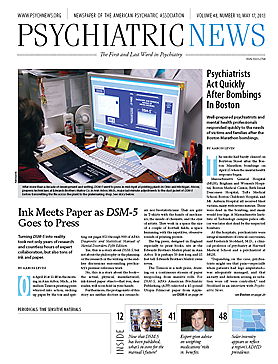Prolonged fatigue is associated with disability and may be an important clinical entity independent of mood and anxiety disorders in adolescents.
Moreover, persistent fatigue with a comorbid mood or anxiety state is related to even more functional impairment, suggesting that prolonged fatigue may reflect greater severity of mood and anxiety disorders in adolescents, according to a study reported in the May American Journal of Psychiatry.
The study found additionally that only 13.7 percent of the adolescents with prolonged fatigue alone had received any type of services for emotional or behavioral symptoms in the preceding year.
“Our findings suggest that fatigue should be comprehensively evaluated in youth,” lead author Kathleen Merikangas, Ph.D., told Psychiatric News. “Fatigue may not simply be ‘laziness’ but rather either an index of a medical condition or of clinical anxiety or depression. Sleep patterns and activity patterns should be evaluated to determine whether behavioral changes might relieve the tiredness. Adolescents with fatigue along with mood or anxiety disorders should also be monitored because our research indicates that fatigue may be an index of greater severity and impairment of these disorders.”
She is with the Genetic Epidemiology Research Branch of the Intramural Research Program at the National Institute of Mental Health (NIMH).
Merikangas and colleagues analyzed data from the National Comorbidity Survey Adolescent Supplement. Participants were 10,123 adolescents aged 13 to 18 years who were interviewed about prolonged fatigue, defined as extreme fatigue with at least one associated symptom (pains, dizziness, headache, sleep disturbance, inability to relax, irritability) that does not resolve by resting or relaxing and lasting at least three months.
They found that the prevalence of prolonged fatigue was 3.0 percent, with 1.4 percent for prolonged fatigue only and 1.6 percent for prolonged fatigue concomitant with a depressive or anxiety disorder. Nearly 60 percent of the adolescents with prolonged fatigue only had severe or very severe disability, and their rates of poor physical and mental health were comparable to those of adolescents with mood or anxiety disorders only.
“The cross-sectional nature of our study prevents us from addressing causation,” Merikangas said. “However, previous studies of both adults and adolescents have shown a bidirectional association between anxiety/depression and fatigue states, with each of these sets of disorders predicting new incidence of the other. So those with fatigue have elevated incidence of mood and anxiety disorders at follow-up, as well as the converse.”
The study was upported by an NIMH Intramural Research Program grant. ■

